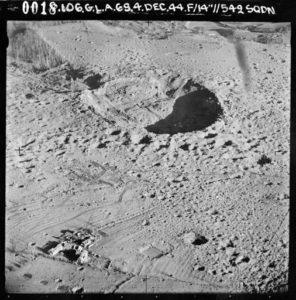The Fauld explosion
A Major Tutbury Tragedy – The Fauld Explosion
At ten past eleven on 27th November 1944, a sunny Monday morning, Britain’s largest ever explosion occurred two miles from Tutbury, killing seventy people and devastating the surrounding countryside.
Gypsum and, in its finer form, alabaster have been mined and quarried in the area for at least 850 years – perhaps since Roman times, but certainly by the Norman masons who constructed the famed alabaster frieze of the west doorway of St Mary’s Church, Tutbury.
In the 19th century gypsum came to be used as plaster in the building trade, and locally the horizontal drift mines of J.C.Staton and Peter Ford & Sons tunnelled into the Stonepit Hills of the Needwood Forest escarpment near the hamlet of Fauld and towards Hanbury. Fords also constructed a plaster works at the mouth of their mine. Mining still continues today under the ownership of British Gypsum, but by the 1930’s many of the tunnel systems had been worked out and become disused.
In 1937 with war looming, the RAF purchased 38 acres of the tunnels as a storage site for bombs and ammunition. Eventually 24,000 tonnes of high explosive bombs, plus incendiaries and detonators, were housed there for distribution by rail around the country’s wartime airfields. Fauld also acted as a repair centre for defective and jettisoned bombs. The Dump, as it was locally known, was shrouded in much secrecy, but by 1944 over a thousand people were employed there, both RAF and civilian personnel, and nearly 200 Italian prisoners of war. An underground railway network was constructed, linked to the sidings across the River Dove in Scropton.
“When the Dump went up”, casualties in the bomb store itself were limited to thirty five by the natural and man-made barriers in the tunnel system which helped contain the effects of the explosion. But six further deaths arose from toxic fumes in the adjoining actively mined areas, plus twenty nine on the surface where Upper Castle Hayes Farm was obliterated, and at Ford’s plasterworks which was engulfed by six million gallons of water, mud and debris when the reservoir serving the works burst its dam.
Local rumour looked towards a V2 rocket or Italian sabotage as the cause. The reality was more mundane. An RAF Court of Enquiry, its findings kept secret until 1974, found that, in a context of wartime shortages and poor managerial supervision, the daily running of the bomb store had become slack and subject to bad practices. “In all probability” the blast was caused by two airmen trying to remove the detonator from a damaged bomb using a brass chisel, rather than a regulation copper one, producing a spark which set off that bomb and in a chain reaction a further 3,800 tons of bombs. A Coroner’s Inquest held in parallel in Burton-on-Trent into the civilian deaths recorded that they were accidental, caused by an explosion whose origin was unclear.
Outside of the local area, knowledge of the incident was limited until after the lifting of the censorship in 1974. Since then interest in the explosion, its impact, causes and victims has increased substantially and a series of pamphlets and books have been published, and media interest is periodically stirred on anniversaries.

Impressive visible evidence of the scale of the explosion can still be seen today in the form of “The Crater”, an immense gash in the landscape where Upper Castle Hayes Farm once stood, covering 12 acres; today it is partly reclaimed by nature, accessible by a half-mile public footpath from the Cock Inn at Hanbury (itself substantially damaged by the blast).
Tutbury Museum holds copies of much of the published literature, together with photographic records of the mining and railway operations. In addition it holds the “Mackay papers”, the Inquest records accumulated by Constable (later Sergeant) Albert Thomas Mackay, who worked as the Coroner’s Officer, and donated to the Museum by his son.
For those with an historical or family interest in the explosion, a visit to the Crater and the Cock Inn is recommended, supplemented by an examination of the Museum’s literature and records.
NOTE – We have a small number of books available to purchase about the Fauld explosion called “Voices from the Explosion” by Valerie Hardy (2nd Edition). These may be inspected and purchased at the Museum for a discounted price of £12.50p